

*(S Rating) Scarcity Rating (includes
scarcity, relevance and content) - with 10 being the most desirable and 1
easiest to acquire. Those highlighted in the deeper shades of red are highly
sought after works.


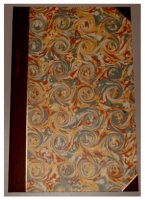 This extremely rare book gives "an
account of the Cape of Good Hope and the Hottentotes". William Rhyne,
a Member of the Council of Justice to the Dutch East India Company, originally
wrote this work in Latin - the book held is the English translation which
was published at Scasshausen in Switzerland in 1704.
This extremely rare book gives "an
account of the Cape of Good Hope and the Hottentotes". William Rhyne,
a Member of the Council of Justice to the Dutch East India Company, originally
wrote this work in Latin - the book held is the English translation which
was published at Scasshausen in Switzerland in 1704.
The book gives a rare insight into the lives of the natives in the very early days of settlement by the Dutch in the Cape - and it is translated into contemporary English from an original report by Zevorzit written in 1671 - less than 20 years after van Riebeeck's party settled in Cape Town.
Extracts read: It's unknown hitherto, what Fort or People borders upon the country of the Hottentotes; for what some have related of the Negroes (commonly called Caffers) is founded upon heresay... The Hottentotes being very much sunburnt have generally a tawny skin tho' some of them have a tolerable white skin; but blackness is the greatest beauty among them, for the rest they either strew a certain Earth, of various colours, upon their heads, or mix the same with Suet, and so besmear their Hair and Faces, which they look upon as a singular Ornament; for there is a certain mountain here, which furnishes them with the materials for diverse colours. which if rightly managed, would turn to a good account. (The Hottentots were the foundation of the Griqua nation).
A very valuable find. Image of opening page at this link.
A copy in perfect condition is in the Balson Holdings Family Trust collection.
Critical comment on this work:A small book of just 20 pages but with some fascinating contemporary drawings and sketches. |

 COSMOGRAPHY IN FOUR BOOKS. CONTAINING
THE CHOREOGRAPHY AND HISTORY OF THE WHOLE WORLD: AND ALL THE PRINCIPAL KINGDOMS,
PROVINCES, SEAS, AND THE ISLES THEREOF, WITH AN ACCURATE AND APPROVED INDEX
OF ALL THE KINGDOMS, PROVINCES, COUNTRIES, INHABITANTS, PEOPLE, CITIES,
MOUNTAINS, RIVERS, SEAS, ISLANDS, FORTS, BAYS, CAPES, FORESTS, &C. OF
ANY REMARQUE IN THE WHOLE WORLD, London, 1682,
COSMOGRAPHY IN FOUR BOOKS. CONTAINING
THE CHOREOGRAPHY AND HISTORY OF THE WHOLE WORLD: AND ALL THE PRINCIPAL KINGDOMS,
PROVINCES, SEAS, AND THE ISLES THEREOF, WITH AN ACCURATE AND APPROVED INDEX
OF ALL THE KINGDOMS, PROVINCES, COUNTRIES, INHABITANTS, PEOPLE, CITIES,
MOUNTAINS, RIVERS, SEAS, ISLANDS, FORTS, BAYS, CAPES, FORESTS, &C. OF
ANY REMARQUE IN THE WHOLE WORLD, London, 1682,
Including: America, Florida, Virginia, Asia, Britain, Palestine, Arabia, Asia, Russia, Italy, Greece, France, Poland, The Alps, Germany, Spain, Africa, Ireland, Belgium, Denmark, Swethland, Hungary, Sclavonia, Dacia, Mount Haemus, Greece, Asia, Asia Minor, Cyprus, Syria, Mesopotamia, Mount Taurus, Turcomania, Iberia, Media, Persia, Tartaria, China, India, The Oriental Islands, Sumatra, Java, Borneo, Egypt, Barbary, Libya Interior, Terra Nigritarum, Aethiopia Superior, Aethiopia Inferior, Isles of Africk, Estotiland, Canada, Virginia, Florida, Nova Gallicia, Guatimala, Nova Hispania, Castella Avrea, Nova Granada, Peru, Chile, Paraguay, Brasil, Guiana, Paria, American Islands, Hispaniola, Cuba, Porto Rico, Monico, The Caribes, Granada, S. Vincent, Barbados, Mantinino, Deseada, Christophers, Sanc A Crux, Jamaica,
Four Volumes In One, HC, Very Good, Folio (9-1/2"x13-3/4"), 943pp plus, Full leather, gilt stamping/ornament at spine, five ribs/six compartments. Pages clean, former owner's bookplate and name front endpaper, edgewear, corners bumped/furred, scuffing/soiling to leather, most cords mended, binding tight, crack to leather at spine.
The book contains the Rare Imprimatur Leaf
A copy in near perfect condition valued at about US$5,000 is in the Balson Holdings Family Trust collection see the images below.
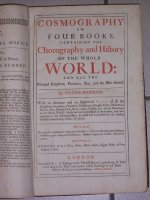 |
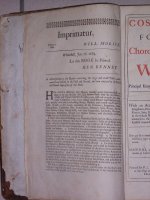 |
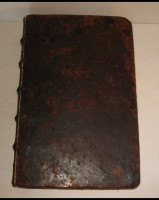 |
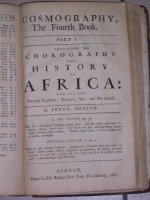 |
Critical comment on this work:A large book weighing over 11 pounds gives a fascinating insight into how the world and Africa was perceived at this time. See also the family trust's very rare original map of Africa by William Berry dated 1680 |
 De Promontorio Bonae Spei (The Cape of Good
Hope) - 1767
De Promontorio Bonae Spei (The Cape of Good
Hope) - 1767
 This extraordinary
60 page translation of the 1767 oratory made by Hemmy to the Hamburg Academy
on the 10th April 1767 gives a wonderful insight into the life at the Cape
at a time when much of history was missed.
This extraordinary
60 page translation of the 1767 oratory made by Hemmy to the Hamburg Academy
on the 10th April 1767 gives a wonderful insight into the life at the Cape
at a time when much of history was missed.
Hemmy describes the Hottentot in similar fashion to Moffat when he says:
This race of men has a good physique, is swift of foot, and averse to hard labour: the majority of them succumb to old age, except those who fall victim to weapons or wild beasts. In colour they are dark rather than black. They are tall and thin, yet so powerful they can withstand the charge of an ox in full career. Their eyes are beautiful but watery, their noses flattened, their breath foul-smelling. Their teeth are ivory white. Their fingers are equipped with little talons, like the claws of eagles. They have graceful ankles and small feet. Their hair is like wool and adorned with pendants or coral` and numerous types of trinkets, made of lead, copper or brass. The great majority of them go about naked or wearing sheepskins they call "Krossen", and which they wear instead of clothing, their private parts they cover with a loin cloth, known as the Kul-Kross. The woman have pendulous breasts, which they can throw over their shoulders and offer to their babies. The chief ornaments of the women are in the form of beads. To protect themselves against the heat of the sun they anoint their faces and bodies with an agent made of animal fat, butter and soot. Some of them live off the raw flesh of animals, the rest eat it half-cooked, dragging the flesh through their teeth.
A copy of the English translation edited by K D White in 1959, in excellent condition, is in the Balson Holdings Family Trust collection.
Critical comment on this work:This work gives a wonderful insight into the early days after the first settlement - with special reference to the beautiful gardens in Cape Town and at Kirstenbosch. |
 A collection of Voyages, Discoveries and Travels
- 1767
A collection of Voyages, Discoveries and Travels
- 1767
 This extremely rare
530 page book with leather binding is in excellent condition for its age.
This extremely rare
530 page book with leather binding is in excellent condition for its age.
The book, written in English and covers African discoveries including the Cape of Good Hope and Mocambique.
An original copy of this book in excellent condition is in the Balson Holdings Family Trust collection.
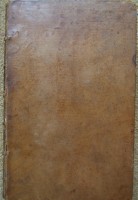 |
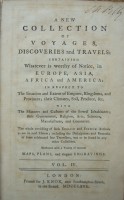 |
Critical comment on this work:A useful work for research purposes - however does not go into the detail about the Cape that other early works do. |
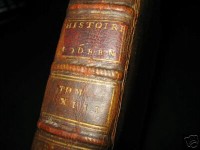 Histoire Moderne Des Africains - 1769
Histoire Moderne Des Africains - 1769
 This extremely rare
530 page book with leather binding is in excellent condition for its age.
This extremely rare
530 page book with leather binding is in excellent condition for its age.
The book, written in French, covers all African discoveries including the Cape of Good Hope and Mocambique.
An original copy of this book in excellent condition is in the Balson Holdings Family Trust collection.
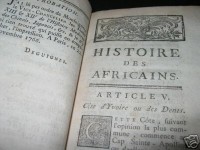 |
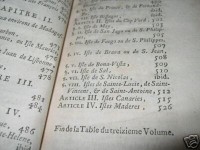 |
Critical comment on this work:A useful work for research purposes - however does not go into the detail about the Cape that other early works do. |
 Histoire Moderne - 1775
Histoire Moderne - 1775
 One of the first
books looking at the early history of Africa.
One of the first
books looking at the early history of Africa.
An original copy of this book in fair condition is held in the Balson Holdings Family Trust collection.
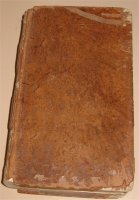 |
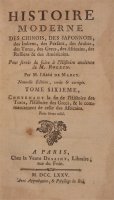 |
Critical comment on this work:A useful work for research purposes - largely focussed on northern Africa |
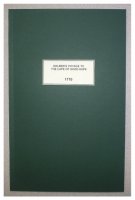 The Present State of the Cape of Good Hope and the
Hottentots - 1770
The Present State of the Cape of Good Hope and the
Hottentots - 1770
 In 1705, Baron Krosick,
Kolben's patron, dispatched him to the Cape in order to establish its longitude
and to study the natural history of the Cape. Kolben compiled what is one
of the first serious accounts in English, on the Cape's interior culture.
The majority of the work comprises detailed descriptions of the Hottentots.
Beginning with a lengthy discussion of Hottentot dress and physical appearance,
Kolben's commentary turns to their 'several nations' and the laws, religious
ceremonies and customs that characterize them. Vivid and compelling anecdotes
depict Hottentot marriage, the course of local justice, initiation rites,
animal husbandry and hunting practices.
In 1705, Baron Krosick,
Kolben's patron, dispatched him to the Cape in order to establish its longitude
and to study the natural history of the Cape. Kolben compiled what is one
of the first serious accounts in English, on the Cape's interior culture.
The majority of the work comprises detailed descriptions of the Hottentots.
Beginning with a lengthy discussion of Hottentot dress and physical appearance,
Kolben's commentary turns to their 'several nations' and the laws, religious
ceremonies and customs that characterize them. Vivid and compelling anecdotes
depict Hottentot marriage, the course of local justice, initiation rites,
animal husbandry and hunting practices.
Kolben records how the Hottentots urinated over each other at major ceremonies like weddings - with the recipient eagerly scratching his or her body so that the urine would sink in. He also records how the young man's rite to adulthood included the removal of the left testicle in a very painful exercise - so that the man could run faster.
A captivating account from a contemporary collection of voyages and travels, in itself complete. This comes from the esteemed and extensive compilation by Edward Cavendish Drake, entitled, "A New Universal Collection of Authentic and Entertaining Voyages and Travels, from the Earliest Accounts to the Present Time. Judiciously Selected from the Best Writers in the English, French, Spanish, Italian, Dutch, German, Danish, and other languages. Comprehending an account of whatever is curious in the Government, Commerce, Natural History, Customs, Marriages, Funerals, and other Ceremonies of Most Nations in the Known World. Including an Account of the Most Remarkable Discoveries, Conquests, Settlements, Battles, Sea Fights, Hurricanes, Shipwrecks, Sieges, Tortures, Wonderful Escapes, Massacres and Strange Deliverances, both by Sea and Land. Also a Description of the Buildings, Mountains, Rivers, Harbours, Lakes, Islands, Peninsulas, Creeks, &c. of Various Countries. The Whole Forming a History of Whatever is Most Worthy of Notice in Europe, Asia, Africa and America. Illustrated with maps from the latest improvements, and beautiful plates, By Grignion, and other celebrated masters."
Folio measuring approximately 8.5 x 13.5 inches. Includes 2 plates featuring Hottentot scenes (seen below) 18 pages from the original volume, attractively bound in forest green cardstock covers with label.
An original copy of this document in excellent condition is held in the Balson Holdings Family Trust collection.
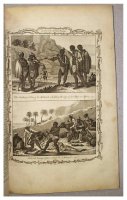 |
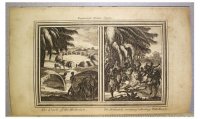 |
Critical comment on this work:A useful work for research purposes - giving a fascinating first hand account into the lives of the Hottentot peoples. |
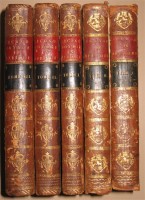 Voyage de Monsieur Le Vaillant dans L' Interieur de
L'Afrique - 1790
Voyage de Monsieur Le Vaillant dans L' Interieur de
L'Afrique - 1790
 Francois le Vaillant's
published accounts of his two voyages into the interior of the Cape of Good
Hope were probably the most popular and influential accounts Europeans had
read on Africa before the nineteenth century. The first book (these two volumes)
cover his trip to the east of the Dutch settlement in South Africa reaching
the Great Fish River and returning through the Karoo. He was one of the first
Europeans to penetrate the interior of southern Africa, reaching the southern
borders of the Kalahari Desert. His work narrates life in the Dutch colony
and the conflicts between the English and the Dutch over possession of the
Cape, including the loss of his collection of flora and fauna when his ship
was attacked by the English. Altogether it is said that he collected about
2000 specimens of birds, as well as others of mammals, insects, plants, and
Hottentot artefacts. Many of these specimens were as yet unknown to science.
He was able to travel in the Cape as a "foreigner" because he was under the
sponsorship of Jacob Temminck, treasurer of the Dutch East India Company.
Francois le Vaillant's
published accounts of his two voyages into the interior of the Cape of Good
Hope were probably the most popular and influential accounts Europeans had
read on Africa before the nineteenth century. The first book (these two volumes)
cover his trip to the east of the Dutch settlement in South Africa reaching
the Great Fish River and returning through the Karoo. He was one of the first
Europeans to penetrate the interior of southern Africa, reaching the southern
borders of the Kalahari Desert. His work narrates life in the Dutch colony
and the conflicts between the English and the Dutch over possession of the
Cape, including the loss of his collection of flora and fauna when his ship
was attacked by the English. Altogether it is said that he collected about
2000 specimens of birds, as well as others of mammals, insects, plants, and
Hottentot artefacts. Many of these specimens were as yet unknown to science.
He was able to travel in the Cape as a "foreigner" because he was under the
sponsorship of Jacob Temminck, treasurer of the Dutch East India Company.
The narrative is characterized by the intelligent and interesting manner in which it is written, although the rhapsodies on the Hottentots must have sounded appalling to British colonial ears and later the apartheid regime. His love passages with the fair 'Narina' (see plate IV below) and his evident admiration for many of the other native women are remarkable for the time (Mendelssohn). Among the plates is that of 'A Hottentot woman', showing the peculiar confirmation sometimes found in females of this race (plate VII see bottom pic below). This plate caused huge scandal and was often suppressed and in later editions it was replaced by another one. His informal writing style and his devotion of space to the Africans living within and beyond the Dutch claimed territory fed his readers' interest in the exotic while providing new information on the interior and its inhabitants. Le Vaillant's reputation suffered when Sir John Barrow took him to task when preparing his own account of the Cape for the English Governor in 1797. His literary license and his Rousseau inspired philosophy on the dignity of the Africans he encountered resulted in such a degree of rejection by subsequent travellers, and English Imperial Historiography, that his two books have only recently been rehabilitated by the anthropologist and historian. It was only in 1963 when a private collection of 165 original paintings he made of his travels and of the flora, fauna and particularly the birds he collected were sold at Sothebys, that the scholarly community learned that Le Vaillant might have been more than just another traveller to the Cape. They were purchased for the Mendelssohn Collection. It is clear that the plates in his printed travel books are taken directly from these paintings.
There were two keys to Le Vaillant's success as a collector of specimens during these voyages. He had been given a new taxidermy formula by Jean-Baptiste Becoeur before the latter died in1777: it was an arsenical soap, and he was thus able to preserve his specimens well. No one else had the recipe for another 20 years. Secondly, he could take advantage of French improvements to the flintlock mechanism on the musket, and could no doubt fire more quickly and with greater accuracy with the improved gun, obviously necessary for shooting birds. Le Vaillant was an energetic naturalist of serious intent, and a pioneer. His faults are overwhelmed by the weight and abundance of his achievements. He is now regarded as the “founder of African ornithology". Copies of the early editions of this book are much much rarer with hand colouring to the plates. Of the eighteen copies sold at auction since in the last thirty years, only three have the plates in colour, and one of these has been censored with an overpainted apron on the plate of the Hottentot woman.
Volume 1: xxiv prelims plus 382 pages. 6 plates: Frontis and 2 folding
plates in black and white, 3 hand coloured plates (seeimages below). ( Plus
chapter heading decorations.)
Volume 2: Title leaf followed by 403 numbered pages. 6 plates, 5 of
which are hand coloured. The "Suppressed Plate" (seen below) is present but
not coloured.
CONDITION DETAILS: The upper boards of the second volume has cracked hinges and both boards have become detached.
The First French first edition of the two volumes, valued at several thousand dollars, is held in the Balson Holdings Family Trust collection - his book on his second trip at this link.
| The supressed plate of a Hottentot woman in the nude seen right displays an extraordinary human deformity which caused a scandal when the book was released.
As a result few copies survived |
Critical comment on this work:This work by Le Vaillant, a French ornithologist, provides a valuable insight into the lives of the Hottentots. |
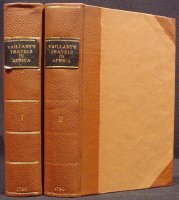 Travels into the Interior Parts of South Africa
- 1790
Travels into the Interior Parts of South Africa
- 1790
 Le Vaillant, a
Frenchman, was one of the first explorers to proceed into the interior
of South Africa.
Le Vaillant, a
Frenchman, was one of the first explorers to proceed into the interior
of South Africa.
His trip lasted between 1780 and 1785 and was extraordinarily explicit in its content. For example the book contains images of a nude Hottentot man and woman (see images below). The image of the woman on page 350 is normally removed making this already rare work even more valuable. The picture of the nude male has been tampered with. Indeed these two pictures caused quite a scandal at the time as did his description of his romance with a "savage".
On his way to the Cape Le Vaillant encountered a British Clipper in Cape waters shortly after the outbreak of war with Batavia. In the ensuing one-sided battle on a Dutch East India boat, which he describes at length, he lost all his worldly possessions and nearly his life.
It was after he lost everything that he started exploring the interior of South Africa and became romantically involved with a Hottentot from the Gonaqua tribe. As a result his descriptions of their lives and lifestyle is as accurate as any found in the diaries of the early explorers. His controversial book of the times romanticises the Hottentots - like Lieutenant Colonel John Sutherland.
In this book Le Vaillant often refers to the Hottentots as "Caffre".
There is some staining and browning in the book but the contents are sound and the pages untrimmed (which is quite common for books of this era).
A first edition copy of the two volumes, valued at several thousand dollars, is held in the Balson Holdings Family Trust collection.
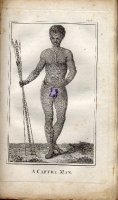 |
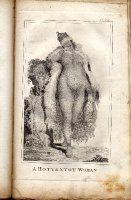 |
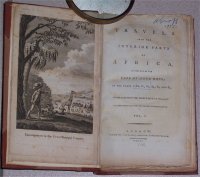 |
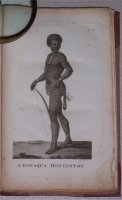 |
Critical comment on this work:This work by Le Vaillant, a French ornithologist, provides a valuable insight into the lives of the Hottentots. |
 A voyage to the Cape of Good Hope vol II
- 1790
A voyage to the Cape of Good Hope vol II
- 1790
 Perth R. Morison Junior. D. Lizars (Engravings) Very Good volume in lightly worn contemporary calf of the pirated edition which was taken from the London Second Edition of 1786.
Perth R. Morison Junior. D. Lizars (Engravings) Very Good volume in lightly worn contemporary calf of the pirated edition which was taken from the London Second Edition of 1786.
Both contents pages bound into volume one; the chapter headings for Vol II are shown in the contents pages as Chapter X onwards, but are, in volume two actually Chapter 1 onwards. Page skip, without loss, from page 136 to 139 in Vol II.
Forster induced Sparrman, a pupil of Linnaeus, to join Cook on the second voyage. Description of the voyage is brief (fourteen weeks in the Antarctic waters receives only a few lines) but he does relate, as an eyewitness, an incident north of New Zealand unrecorded in logs or journals, when the Resolution and Adventure avoided a serious collision by only a hairsbreadth. Tha majority of the text and all the plates deal with his journeys and natural history excursions in South Africa, despite his visiting and studying same in New Zealand and the Pacific Islands on this second Cook voyage. 12mo, pp, xx, 264.; pp 261. Pencilled sketches of Dutch East India Company boats at both front and back.
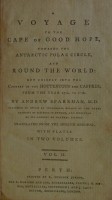 |
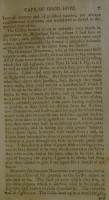 |
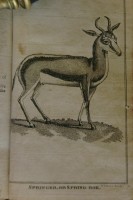 |
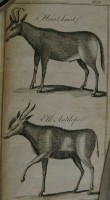 |
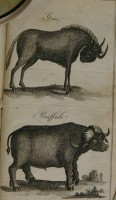 |
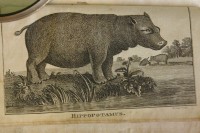 |
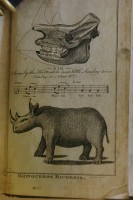 |
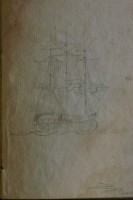 |
Critical comment on this work:EXtremely old and rare book with important comments about contact with the Hottentots. |
 Second Voyage dans l'interieur de L'Afrique - 1790
Second Voyage dans l'interieur de L'Afrique - 1790
 Second Voyage dans
l'interieur de L'Afrique par le Cap de Bonne-Esperance dans les Anees 1783,
84 et 85 " 3 volume set. Contemporary full brown leather bindings with red
and black title panels on spine. Gilt decorated.
Second Voyage dans
l'interieur de L'Afrique par le Cap de Bonne-Esperance dans les Anees 1783,
84 et 85 " 3 volume set. Contemporary full brown leather bindings with red
and black title panels on spine. Gilt decorated.
Vol 1: xliv prelims, 304 text pages followed by 2 pages of errata,
5 black and white plates, 3 are folding.
Vol 2: 426 pages followed by 2 errata pages.8 plates, of which 2 are
folding.
Vol 3: 525 numbered pages of text plus two title leaves, 2 errata
pages, list of plates and Jansen's book list. 9 black and white engravings.
A first edition copy of the book is held in the Balson Holdings Family Trust collection - his books in French on his first trip can be seen at this link.
Critical comment on this work:A young man and his adventures exploring the new world |
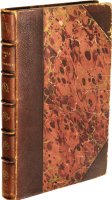 Travels in Various Parts of Europe, Asia, and Africa, During
a Series of Thirty Years and Upwards
Travels in Various Parts of Europe, Asia, and Africa, During
a Series of Thirty Years and Upwards
 (London: Printed
for the Author, 1790)
(London: Printed
for the Author, 1790)
First edition, 404 pages, 8vo (5.75" x 8.75"), bound in half leather with marble boards, five raised spine bands with gilt titles and decoration, in very good condition with some moderate wear to the corners resulting in wear down to the boards.
From the title page: "After the Ruin of his Family in 1745, was thrown when a Child on the wide World; the Ways of which, with many curious, useful, and interesting Particulars he had occasion to observe, and has taken care, by Means of a regular Journal, to record, while he served, in various departments, a great number of Noblemen and Gentlemen, English, Scotch, Irish, Dutch, etc., etc.".
A first edition copy of the book is held in the Balson Holdings Family Trust collection.
Critical comment on this work:A young man and his adventures exploring the new world |
 The
European Magazine (Vol XXIX) January - June 1796
The
European Magazine (Vol XXIX) January - June 1796
 This rebound book
contains the entire "magazine" from January to June 1796.
This rebound book
contains the entire "magazine" from January to June 1796.
The article on page 82 which relates to the Hottentots and interesting references to a Swiss regiment of 700 men following the fall of the region to the British as a bounty of war.
The Hottentot Hollands Pass is referred to as the boundary between the Dutch Settlers and the original inhabitants of the region, the Hottentots.
A first edition copy of the book is held in the Balson Holdings Family Trust collection.
Critical comment on this work:A short but interesting insight into a turbulent period as the Cape was claimed by the British from the Dutch as bounty for war in Europe |
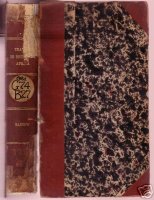 An Account of Travels into the Interior of Southern
Africa - 1802
An Account of Travels into the Interior of Southern
Africa - 1802
 This extremely rare
386 page hardback half leather book with marbled boards is in average
condition. The cover is cracked and just attached to the book - and there
is some scattered foxing throughout which is quite bad on the first few pages.
This ex-library (Springfield, Massachusetts) book is the First American edition
replicated from the London Quarto Edition. Published by NY, G.F. Hopkins,
for John Conrad & Co. in 1802
This extremely rare
386 page hardback half leather book with marbled boards is in average
condition. The cover is cracked and just attached to the book - and there
is some scattered foxing throughout which is quite bad on the first few pages.
This ex-library (Springfield, Massachusetts) book is the First American edition
replicated from the London Quarto Edition. Published by NY, G.F. Hopkins,
for John Conrad & Co. in 1802
The book, covers Barrows travels into South Africa during 1797 and 1798 and includes Cursory Observations on the geology and geography of the Southern part of that continent ; the natural history of such objects as occurred in the animal, vegetable, and mineral kingdoms; and sketches on the physical and moral characters of the various tribes of inhabitants surrounding the settlement of the Cape of Good Hope.
Chapters include: general view of the Cape , and a more particular description of the promontory call The Cape of Good Hope ; Sketches on a journey from The Cape of Good Hope , across the Karroo ...to the Drosdy of Graaff Reynet ; Sketches on a journey into the Country of the Kaffers ; Sketches on a journey int the Country of the Bosjesmans ; Sketches on a journey from Graaff Reynet along the sea-coast to the Cape ; Sketches on a journey into the Country of the Namaquas
An original copy of this book in poor condition is in the Balson Holdings Family Trust collection.
See also French copy: Voyage Dans La Partie Meridionale De L'Afrique
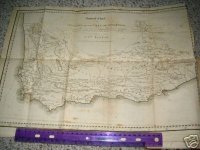 |
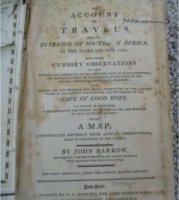 |
Critical comment on this work:A useful work for research purposes - Barrow, like Le Vaillant, was one of the first explorers into South Africa to record his experiences. |

![]() London:
1820 8vo., 24pp. (also numbered pp.97-120), recently well bound in linen-backed
marbled boards lettered. Oval ink stamp of L.S.E. on verso of title-page,
but still a very good copy. The text in original form is extremely rare and
equaly historic in nature - being the catalyst for the 1820 settlers.
London:
1820 8vo., 24pp. (also numbered pp.97-120), recently well bound in linen-backed
marbled boards lettered. Oval ink stamp of L.S.E. on verso of title-page,
but still a very good copy. The text in original form is extremely rare and
equaly historic in nature - being the catalyst for the 1820 settlers.
From the Pamphleteer, vol.XVII, no.33. Mullen 340. Mendelssohn p.223. The pamphlet was first published separately in 1819. This was one of Burchell's "two or three very judicious pamphlets on the subject of Cape emigration" (DNB).
The author recommends those who wish to emigrate from England to consider the advantages offered by the Cape of Good Hope. 'He reflects on the number of persons who are yearly quitting these shores, weakening the strength of the Empire to add to the population of countries that may unfortunately, at some future time, employ them or their descendants in shedding British blood', and he is anxious that these people should go to an English colony. He gives a short sketch of the Cape, and suggests that a sufficient number of English emigrants should be located in a specific tract of country, instead of mixing them up indiscriminately with the Boer population, which would hereafter 'form a serious impediment in the way of new settlers' unacquainted with the Dutch language.
He gives a short sketch of the Cape, and suggests that a sufficient number of English emigrants should be located in a specific tract of country, instead of mixing them up indiscriminately with the Boer population, which would hereafter 'form a serious impediment in the way of new settlers' unacquainted with the Dutch language". [Mendelssohn loc. cit.] William J. Burchell (1782 -1863), explorer and naturalist, travelled extensively in South Africa, 1811-1815, making scientific observations and collecting natural history specimens. He published an account in 1822.
William John Burchell is regarded as one of the greatest of the early African explorers. He was an accomplished naturalist, who amassed vast natural history collections and described many new species. In his account, he advocates emigration from England to to the Cape, and presents the advantages.
An original copy of this booklet in excellent rebound condition is in the Balson Holdings Family Trust collection.
Critical comment on this work:A fascinating and historic work by one of South Africa's best known explorers. |
 A Journal of a Visit to South Africa - 1821
A Journal of a Visit to South Africa - 1821
 This extremely rare
580 page second (British) edition hardback half leather book with marbled
boards is in excellent condition. Although the book is the second edition
it is harder to find than the expensive first edition.
This extremely rare
580 page second (British) edition hardback half leather book with marbled
boards is in excellent condition. Although the book is the second edition
it is harder to find than the expensive first edition.
The book was once the property of Boston College Library, Chestnut Hill.
The book, covers Latrobe's travels along the south coast of South Africa in 1816. His route can be seen by clicking on the image below.
Latrobe left England to visit the missionaries at Genadendal and Groenekloof. As the Governor of the Cape had expressed a wish that a third missionary post should be opened, the author travelled through a large part of the country in order to choose a suitable site. From Groenekloof his journey led him to Genadendal via Zwellendam, Zeekogat, Welgelegen, Uitenhage to the Witte River and thence to the Little Fish river. Amongst others he gave an account of the life of the up-country farmers at this period, observing that they existed in an extremely primitive manner, concerned only with leaving their descendants a good herd of cattle, and taking little interest in the cultivation or advancement of the country. He also described what has become known as the "Slachter's Nek" episode; the execution of five rebels in the district of Uitenhage.
The book is written as a journal and includes a comprehensive index at the back.
The following statement can be seen on page 120 of the book regardng the
acquisition by the early settlers of land at Gnadenthal just 130 miles north
east of Cape Town. This process of leganised theft from the Hottentot population
was replicated around the Griqua lands of Philippolis by the Boers a few
years later:
This place (Stoffels-Kraal) likewise belonged
to a tribe of Hottentots, but was taken from them, by a species of robbery,
very common in former days, when for a few bottles of brandy, or some other
trifling consideration, the best lands in their possession were purchased
of them; and the Hottentot captain, perhaps, in a state of intoxication,
led to some magistrate, by whom the shameful bargain was ratified. The poor
fellow did not come to his senses, till too late to recant, when he perceived
with dismay, how he had suffered himself and his people to be
duped.
An original copy of this book in excellent rebound condition is in the Balson Holdings Family Trust collection.
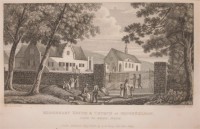 |
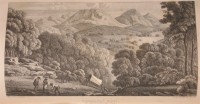 |
Critical comment on this work:A useful work for research purposes when studying the lives of the Hottentots on the coast of the Cape. |
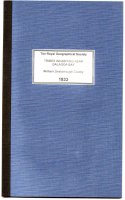
 A twelve page extract from the Royal
National Geographic Society magazine. Comes with a contemporary map that
present Delagoa Bay (aka Lourenco Marques) in Mozambique as the centre of
the South African universe.. and so it was at this time.
A twelve page extract from the Royal
National Geographic Society magazine. Comes with a contemporary map that
present Delagoa Bay (aka Lourenco Marques) in Mozambique as the centre of
the South African universe.. and so it was at this time.
The Britain had only recently taken control of the Cape and the Dutch were still very much the most dominant white settlers in the region. And Portuguese owned Delagoa Bay would continue to be an important link for the descendants of the Dutch well after the Boer war.
Interesting is the spelling of such peoples as the "Zoolahs" (Zulus) and places like Latakoo "Litakoo" in the region where Robert Moffat played such an important role at this time.
This important comment sums up the changes that would soon impact on the Griquas (pp 319)
The Griquas possess horses; and if these, with good cattle, were imported into the wealthier countries farther to the north east, they would no doubt prove very acceptable to a people who, with all their industry, still retain an affection for their pastoral pursuits.
A copy of the interesting article and map (see below) is held in excellent
condition in the Balson Holdings Family Trust collection.
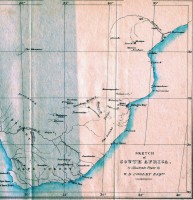
Critical comment on this work:Although this is an interesting article it is amazing how poorly informed the author was about when it came to the people of southern Africa! |
 This 48 page inquiry
sought by the British Government looks at the impact of white settlement
on the native tribe of South Africa - extending to the extermination of the
bushmen in large parts of South Africa by the Griquas (period covered: 1652
to 1841). This extremely rare book cannot be found for sale on the Internet.
This 48 page inquiry
sought by the British Government looks at the impact of white settlement
on the native tribe of South Africa - extending to the extermination of the
bushmen in large parts of South Africa by the Griquas (period covered: 1652
to 1841). This extremely rare book cannot be found for sale on the Internet.
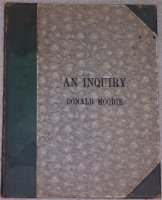 |
|
The Munger Africana Library |
The other rebound copy |
Moodie states that "A population of 200,000 Hottentots in the Cape was reduced to just 32,000 (under the Dutch) "through a continued system of oppression". This comment is carried in the foreward of Balson's book "Children of the Mist". The Hottentots were the foundation of the Griqua people. The book spells out how the Griqua people in the 1820s decimated the Bushman population around Philippolis - clearly survival of the fittest is the cornerstone of all species on earth.
The book, highly critical of Dr Philip at Philippolis and Mr Read at Bethelsdorp, was written before the boers displaced the Griquas from the same lands they had taken from the Bushmen.
Extracts of this work at this link
The Balson Holdings Family Trust collection holds two copies of the
first edition book published in 1841 in excellent condition.
Critical comment on this work:This is a fascinating work which looks at the impact of settlement on the native tribes. The book is based on a number of letters and statements made by prominent people including Dr Philip (who established Philippolis as a reserve for the Bushmen and Lieutenant General Stockenstrom - the Magistrate in the northern Cape near Philippolis). The handing over of the territory to the Griquas under Adam Kok not long after Rev John Campbell's visit to Griqua Town was disastrous with the Bergenaars under Hendrick Hendricks literally exterminating the very people (the Bushmen) who he had been empowered to protect. The Griqua's later complaints to the British about the boer occupation of "their" lands at Philippolis should be seen in light of the manner in which they secured this territory from the original inhabitants, the Bushmen. |

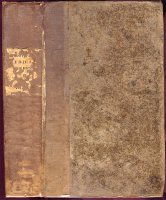 Memoir respecting the Kaffers, Hottentots and
Bosjemans - Lieut Col John Sutherland
Memoir respecting the Kaffers, Hottentots and
Bosjemans - Lieut Col John SutherlandExtremely rare, voluminous 710 and 432 page hard covered books providing a valuable compilation based on Moodie's Records and the works of many of the early writers on South African matters. The books covers reports on the Kaffers, Hottentots and Bosjeman from the earliest days - including the months after van Riebeeck first settled in the Cape and records how hard it was to get the people to sell their livestock.
The spare book held by the Balson Holdings Family Trust was once in the library of Ruth and Walter Middelmann - embossed sticker. The Middelmann's built a large protea industry in the Cape.
The author, Lieutenant Colonel John Sutherland, was a controversial character in those times because he often took and understood the indigenous people and their needs. He was seen as eccentric - with his comments on the early reports, often taking the side of the Hottentots being ridiculed.
A fascinating work - along the lines of le Vaillant
The Balson Holdings Family Trust holds copies of the two extremely rare volumes of this book and a spare of the second volume - all books valued at about US$500 each. It cannot be found for sale on the Internet.
Critical comment on this work:Excellent work which is based on the earliest reports of the Cape. |

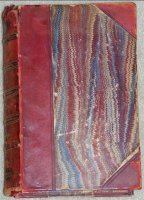 Races
of Men - A Fragment - Dr Robert Knox (1850)
Races
of Men - A Fragment - Dr Robert Knox (1850)
London: Henry Renshaw, 1850. This rare first edition in need of re-binding; 12 x 19 cm with 479 pages. Half leather/marbled with marbled endpapers. The boards are scuffed & worn with rear board detached and damaged spine cover. The binding appears intact but is uneven and loose. Internally there is a small booksellers and a prior owner’s name in ink on the flyleaves and the frontispiece picture is missing.. The pages are evenly yellowed with age but are otherwise in good, unfoxed condition apart from one small edge tear and what could be a repaired tear on page 229 which does not affect the text.
This book is written by Dr Robert Knox of Burke and Hare fame (murderers
from whom he unsuspectingly bought bodies for anatomical study and thus lost
his reputation ). The book is based on Knox's public lectures and was written
9 years before Darwin’s ‘Origin of the Species…’ at a
time when racism was morally and intellectually acceptable at all levels
of society in Scotland. Not just racism as we now understand it, but the
idea that people exist as races and not as nations and that there are huge,
irreconcilable differences within the ‘Caucasians’.
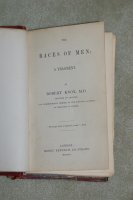 Image right: Fronticepiece "Races of
Men"
Image right: Fronticepiece "Races of
Men"
Knox was much opposed to Imperialism and recognised the terrible injustices
of the time. For example he says, "ask the......whence comes his contempt
and inward dislike to the Hottentot, .... the Caffre; ask him for his warrant
to reduce these unhappy races to bondage and to slavery; to rob them of their
lands, and to enslave their children; to deny them the inalienable right
of man to a portion of the earth on which he was born? If he be an honest
and straightforward man, he will point to the fire-arms suspended over the
mantelpiece - "There is my right!". The statesmen of modern Europe manage
such matters differently; they arrive it is true, at the same result - robbery,
plunder, seizure of the lands of others - but they do it by treaties, protocols,
alliances......". Knox is also remarkably prescient about the future
importance of the United States and conflict in Europe.
The Balson Holdings Family Trust holds a good copy of the book which needs
rebinding.
Critical comment on this work:A fascinating read – despite the faulty logic and lack of evidence for many of the arguments - and the author gives candid opinions about events of the time and some of his contemporaries. |

 This extremely rare
early edition of The Diamond News carries a front page of contemporary
advertisements including reference to the evolving De Beers mine which is
today the largest diamond mining conglomerate in the world. It comes in a
large folded A1 sized sheet with an A4 sized news insert - both sides of
the paper have been used.
This extremely rare
early edition of The Diamond News carries a front page of contemporary
advertisements including reference to the evolving De Beers mine which is
today the largest diamond mining conglomerate in the world. It comes in a
large folded A1 sized sheet with an A4 sized news insert - both sides of
the paper have been used.
The main article in the paper looks at the controversy over the annexation of the diamond fields of Kimberley by the British in the Cape - and the impact that that would have on the Boers.
The fact that the Boers stole these lands from the Griqua in the first place is totally overlooked. There are one or two advertisements in Dutch while the rest are in English. See images below.
.
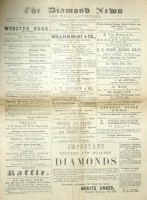 |
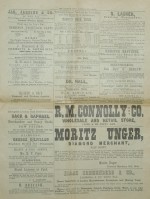 |
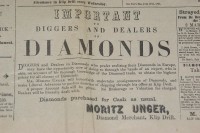 |
The Front Page |
Back Page |
An interesting Ad |
The Balson Holdings Family Trust hold this original paper in excellent condition.
Critical comment on this work:Newspapers have always had their own underlying agenda - but the ads of the time make this paper so fascinating! |
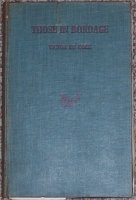 Those in Bondage
- Victor de Kock (1950)
Those in Bondage
- Victor de Kock (1950)
This hard to come by book covers the life of the slaves in the Cape in the days of the Dutch East India Company.
de Kock worked among the manuscripts of the Dutch East India Company held in the Cape. These manuscripts covered the seventeenth and eighteenth centuries. Through is work and access to the document de Kock was able to recreate the early life of the Cape.
The Balson Holdings Family Trust hold an excellent copy signed by the author (five times) to his "attorney friend" Milne.
Critical comment on this work:The book gives a stunning insight into the life of a slave and the early life of the Hottentots - the foundation of the Griqua people. |
Of this edition two hundred copies in a special quarter-leather deluxe binding have been signed by the author. This is number 13. Small folio; original quarter calf, with spine gilt, and tooled in compartments; marbled boards; pp. xv + (i) + 222; colour frontis. tipped in; monochrome illustrations and maps throughout. Bottom fore-corners of boards very slightly bumped; small pale stain to fore-edge of early prelims. Very good condition.
This book covers the first fifty years of the Dutch colonisation at the Cape, as seen by callers. During the years while it was in preparation I took the opportunity of having the MS read by various friends.
The two most valuable criticisms made of it (in each case by more than one reader) were:
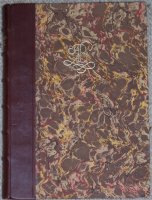 historian
- but not all readers are historians), followed by short extracts from official
documents such as the Diary ("Dagregister", "DR") kept at the Cape; Resolutions
passed by the "Council of Policy", the ruling body here; Letters from this
to the "Lords XVII", the Directors of the Honourable Dutch East-India Company
in Holland, and vice versa; etc.
historian
- but not all readers are historians), followed by short extracts from official
documents such as the Diary ("Dagregister", "DR") kept at the Cape; Resolutions
passed by the "Council of Policy", the ruling body here; Letters from this
to the "Lords XVII", the Directors of the Honourable Dutch East-India Company
in Holland, and vice versa; etc.
All these are translated from the original text: it is a continual surprise to me how modern writers are content to rely on second-hand versions from, e.g., Theal, Leibbrandt, Moodie and even Walker when exceptionally good Archives are available at The Hague and in Cape Town. These extracts are not however intended to form a skeleton history of the Colony, but rather to confirm or contradict statements made by the writers of the items included.
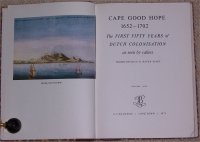 |
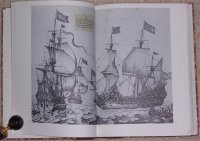 |
|
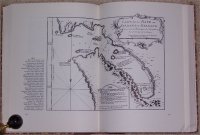 |
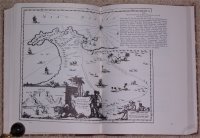 |
The Balson Holdings Family Trust hold an excellent copy signed by the author.
Critical comment on this work:The book provides an excellent record into the early days of the Cape as recorded by its earliest white inhabitants. |